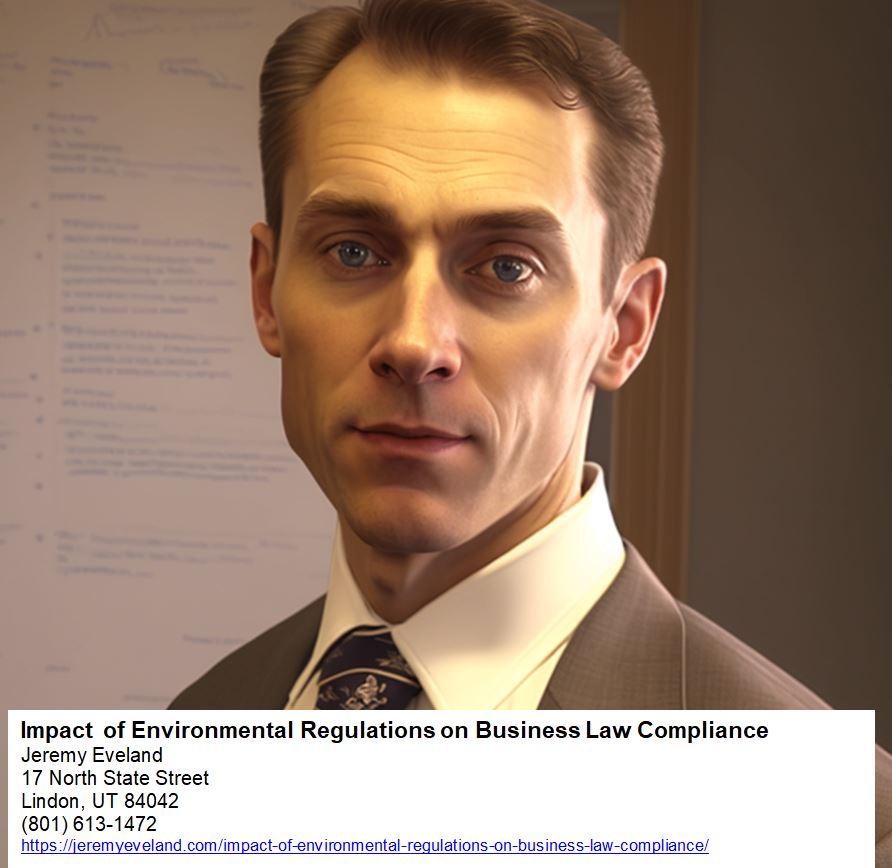In the ever-evolving world of real estate, it is paramount to be aware of the stringent environmental regulations that govern the industry. From zoning restrictions to hazardous waste management, navigating the complex landscape of legal compliance can be a daunting task. In this article, we will explore the intricacies of environmental regulations in real estate, ensuring that you are equipped with the knowledge to make informed decisions and protect both your investments and the environment. Whether you are a developer, investor, or homeowner, understanding these regulations is crucial. Contact attorney Jeremy Eveland for expert guidance and a comprehensive consultation.
Overview of Environmental Regulations in Real Estate
When it comes to real estate, environmental regulations play a crucial role in ensuring the protection of the environment and the health and safety of individuals. Understanding and complying with these regulations is essential for all parties involved in real estate transactions, including property owners, developers, agents, brokers, and buyers. This article aims to provide you with a comprehensive overview of the various environmental regulations in real estate, the key laws and policies governing them, the importance of environmental due diligence, the significance of proper documentation, the responsibilities of real estate professionals, the potential liabilities and enforcement actions, strategies for managing environmental risks and impacts, and the importance of seeking legal assistance for environmental compliance. By the end of this article, you will have a better understanding of the importance of legal compliance in real estate and how it can help protect the environment and your real estate investments.
Understanding the importance of legal compliance
Environmental regulations in real estate are put in place to safeguard the environment and prevent activities that may have adverse impacts on human health, natural resources, and ecosystems. Compliance with these regulations is crucial to prevent pollution, contamination, and other harmful activities that can lead to long-lasting consequences. By adhering to environmental regulations, real estate professionals can ensure the sustainability, safety, and marketability of their properties, as well as mitigate potential risks and liabilities.

Types of environmental regulations in real estate
Environmental regulations in real estate encompass a wide range of topics, including air quality, water quality, waste management, land contamination, endangered species protection, and more. These regulations can be federal, state, or local, and compliance requirements may vary depending on the location and nature of the property. Some common types of environmental regulations include zoning and land use regulations, stormwater management regulations, hazardous materials handling and disposal regulations, and regulations pertaining to wetlands and protected areas.
The role of government agencies in enforcing regulations
Government agencies at the federal, state, and local levels play a crucial role in enforcing environmental regulations in real estate. These agencies are responsible for monitoring compliance, conducting inspections, issuing permits and approvals, and imposing penalties for non-compliance. Examples of key agencies involved in enforcing environmental regulations include the Environmental Protection Agency (EPA), the Department of Environmental Protection (DEP), and local planning and zoning boards. It is important for real estate professionals to be aware of the regulatory oversight and the specific requirements set forth by these agencies.

Implications of non-compliance
Non-compliance with environmental regulations can have severe consequences for all parties involved in real estate transactions. Property owners, developers, agents, and brokers who fail to comply with regulations may face fines, penalties, and potential criminal charges. Non-compliance can also result in civil litigation, where affected parties may seek compensation for damages caused by environmental violations. In addition to legal implications, non-compliance can damage reputation, hinder project approvals, delay construction, and impact the overall value of the property. Therefore, it is crucial for all real estate professionals to prioritize compliance and take proactive measures to meet all environmental requirements.
Key Environmental Laws and Policies
In addition to regulations, there are several key laws and policies that have a significant impact on environmental compliance in the real estate industry. Understanding these laws and policies is essential for ensuring legal compliance and avoiding potential liabilities. Here are four important environmental laws and policies that real estate professionals should be familiar with:
The Comprehensive Environmental Response, Compensation, and Liability Act (CERCLA)
Also known as the Superfund Act, CERCLA was enacted in 1980 to address the cleanup of hazardous waste sites in the United States. This law provides the authority for the EPA to identify, investigate, and remediate contaminated sites, and establishes liability for parties involved in the generation, disposal, and transportation of hazardous substances. Property owners and developers must be aware of potential liabilities associated with contaminated sites and take necessary actions to ensure proper cleanup and compliance with CERCLA.
The Resource Conservation and Recovery Act (RCRA)
The RCRA, passed in 1976, regulates the management and disposal of hazardous waste generated by industrial facilities. This law establishes a cradle-to-grave system for the proper handling, storage, treatment, and disposal of hazardous waste. Real estate professionals, especially those involved in the sale or lease of industrial properties, must understand the requirements of RCRA and ensure compliance with hazardous waste management regulations.
The Clean Water Act (CWA)
Enacted in 1972, the Clean Water Act regulates the discharge of pollutants into the waters of the United States and aims to restore and maintain the quality of the nation’s waters. The CWA establishes permitting requirements for facilities that discharge pollutants and sets water quality standards to protect human health and the environment. Real estate professionals involved in the development or operation of properties with potential impacts on water quality must comply with the CWA and obtain the necessary permits to avoid violations and penalties.
The Clean Air Act (CAA)
The Clean Air Act, passed in 1970, is a federal law that regulates air emissions from stationary and mobile sources to protect air quality and public health. The CAA establishes emissions standards for various pollutants and requires permits for the construction and operation of certain industrial facilities. Property owners and developers must comply with the CAA to minimize air pollution and ensure that their activities do not harm air quality or violate emission limits.
Environmental Due Diligence in Real Estate Transactions
Environmental due diligence is a critical process in real estate transactions that involves assessing potential environmental risks and liabilities associated with a property. Conducting thorough due diligence is essential to identify any existing or potential environmental issues that may impact the property’s value, marketability, and legal compliance. By performing environmental due diligence, real estate professionals can make informed decisions, mitigate risks, negotiate appropriate terms, and protect themselves from potential legal and financial liabilities.
Purpose and benefits of environmental due diligence
The purpose of environmental due diligence is to identify, evaluate, and manage potential environmental risks associated with a property. By conducting environmental due diligence, real estate professionals can:
- Identify any existing or potential environmental contamination on the property
- Assess the potential costs and liabilities associated with environmental issues
- Evaluate the property’s compliance with environmental regulations
- Determine the suitability of the property for the intended use
- Facilitate negotiations, financing, and insurance coverage
- Preserve the value of the property and protect against future litigation
Phases of environmental due diligence
Environmental due diligence typically consists of several phases, each with its own objectives and activities. The phases may vary depending on the scope and complexity of the transaction, but generally include the following:
-
Phase I Environmental Site Assessment (ESA): The Phase I ESA involves a thorough review of historical records, site inspections, and interviews to identify potential environmental concerns associated with the property. This phase aims to identify recognized environmental conditions (RECs) that may impact the property’s value and legal compliance.
-
Phase II Environmental Site Assessment: If the Phase I ESA identifies potential environmental issues, a Phase II ESA may be necessary. This phase involves collecting and analyzing soil, water, and air samples to confirm or rule out the presence of contamination. The results of the Phase II ESA help assess the extent of contamination and determine the appropriate remediation measures, if needed.
-
Remediation and Compliance: If contamination is confirmed, remediation measures must be undertaken to clean up the site and restore it to an acceptable condition. Real estate professionals must comply with all necessary regulations and obtain any required permits or approvals to remediate the site effectively. It is important to engage qualified environmental consultants and contractors to ensure proper remediation and compliance.
Environmental site assessments (ESA)
Environmental site assessments (ESAs) are a critical component of environmental due diligence in real estate transactions. ESAs involve a comprehensive evaluation of a property’s environmental history, current conditions, and potential risks. The purpose of an ESA is to identify any existing or potential environmental issues that may affect the value, marketability, and legal compliance of the property. ESAs typically include a review of historical records, interviews with current and former property owners, visual inspections, and may also include sampling and laboratory analysis to confirm contamination.
Identifying potential environmental risks and liabilities
During the environmental due diligence process, real estate professionals must identify and assess potential environmental risks and liabilities associated with a property. These risks can include contamination from hazardous substances, presence of asbestos or lead-based paint, storage of hazardous materials, proximity to wetlands or protected areas, and more. By identifying these risks, real estate professionals can make informed decisions, take appropriate actions, and allocate responsibilities to mitigate risks and protect against potential liabilities.
The Importance of Proper Documentation
Proper documentation is crucial in demonstrating compliance with environmental regulations and protecting against potential liabilities. Real estate professionals must maintain accurate and organized records to prove their efforts in meeting environmental requirements, obtaining necessary permits and approvals, conducting environmental due diligence, and implementing compliance plans. Here are some key aspects of proper documentation in the context of environmental compliance:
Record keeping and document retention requirements
Real estate professionals must maintain records of all environmental due diligence activities, including the results of site assessments, environmental reports, permits, correspondence with regulatory agencies, and any remediation or mitigation efforts. These records should be retained for a specified period to meet regulatory requirements and preserve evidence of compliance.
Environmental permits and approvals
Real estate professionals must obtain any necessary environmental permits and approvals before initiating activities that may impact the environment. This can include permits for stormwater discharges, wetland impacts, air emissions, hazardous waste management, and more. Documenting the acquisition of these permits and approvals is crucial to demonstrate compliance and avoid potential penalties or enforcement actions.
Environmental impact statements (EIS)
For larger development projects, an Environmental Impact Statement (EIS) may be required. An EIS is a detailed report that evaluates the potential environmental impacts of a project and proposes mitigation measures to minimize those impacts. Real estate professionals must ensure that an accurate and comprehensive EIS is prepared and submitted in compliance with applicable regulations.
Environmental compliance plans
Real estate professionals can benefit from developing and implementing environmental compliance plans to ensure ongoing compliance with regulations. These plans outline the steps and actions necessary to achieve and maintain environmental compliance and mitigate potential risks. Proper documentation of compliance plan implementation demonstrates a commitment to environmental protection and can help reduce potential liabilities.

Responsibilities of Real Estate Professionals
Real estate professionals, including agents, brokers, property owners, and developers, have certain responsibilities when it comes to environmental compliance in real estate transactions. Understanding and fulfilling these responsibilities is vital to ensure legal compliance, protect the environment, and safeguard the reputation and financial interests of all parties involved.
Role of real estate agents and brokers
Real estate agents and brokers have a responsibility to disclose any known environmental issues that may affect the market value, desirability, or habitability of a property. This obligation extends to both residential and commercial transactions. Agents and brokers should communicate openly and honestly with clients about any environmental risks or liabilities associated with the property and assist clients in making informed decisions.
Legal obligations for disclosure of environmental issues
Real estate professionals must comply with applicable laws and regulations regarding the disclosure of environmental issues. This includes disclosing any known environmental contamination, hazardous materials or waste, flood zones, wetlands, or other relevant factors that may impact the property’s value or use. Failure to disclose material information can lead to legal disputes and potential liabilities for the real estate professional.
Mitigating risks through proper communication and due diligence
Real estate professionals can help mitigate environmental risks in real estate transactions by practicing effective communication and conducting thorough due diligence. By openly discussing environmental concerns with clients, advising on the importance of environmental due diligence, and recommending appropriate experts and consultants, real estate professionals can assist clients in identifying and addressing potential risks early in the transaction. This proactive approach can help protect clients from potential liabilities and promote ethical and sustainable real estate practices.
Liability and Enforcement Actions
Non-compliance with environmental regulations can result in various forms of liability and enforcement actions. Real estate professionals must be aware of these potential consequences and take steps to mitigate risks and ensure legal compliance.
Potential liabilities for property owners and developers
Property owners and developers can face liability for environmental violations. This includes liability for the cleanup and remediation of contaminated sites, costs associated with environmental damage, fines and penalties imposed by regulatory agencies, and potential legal claims by affected parties. It is essential for property owners and developers to proactively manage risks, conduct thorough due diligence, and seek professional guidance to minimize potential liabilities.
Fines, penalties, and potential criminal charges
Non-compliance with environmental regulations can result in substantial fines and penalties imposed by regulatory agencies. These fines can vary depending on the severity of the violation, the harm caused to the environment, and the previous compliance record of the violator. In some cases, intentional or reckless violations of environmental regulations can lead to criminal charges, including fines and imprisonment.
Civil litigation and environmental claims
Non-compliance with environmental regulations can also expose real estate professionals to civil litigation and potential claims from affected parties. Individuals or groups impacted by environmental violations, such as neighboring property owners or environmental advocacy organizations, may pursue legal action to seek compensation for damages caused by the violation. Civil litigation can be costly and time-consuming, underscoring the importance of legal compliance and proactive risk management.
Defenses and strategies for mitigation
Real estate professionals can employ various defenses and strategies to mitigate environmental risks and potential liabilities. These may include demonstrating compliance efforts and due diligence, conducting thorough environmental due diligence, obtaining appropriate insurance coverage, engaging qualified professionals, documenting compliance measures, and implementing environmental management systems. By taking proactive measures and seeking professional guidance, real estate professionals can strengthen their defenses and minimize potential liabilities.
Managing Environmental Risks and Impacts
Real estate professionals can play an active role in managing environmental risks and minimizing impacts on the environment through the implementation of sustainable practices and environmental management systems.
Implementing environmental management systems (EMS)
Environmental management systems (EMS) provide a structured framework for managing environmental impacts and ensuring ongoing compliance with regulations. An EMS helps real estate professionals identify and prioritize environmental issues, establish goals and targets, allocate resources, implement controls and procedures, and monitor performance. By implementing an EMS, real estate professionals can demonstrate their commitment to environmental protection, improve efficiency, reduce waste, and enhance the sustainability of their operations.
Sustainable practices for real estate development
Real estate development can have significant environmental impacts, including habitat destruction, biodiversity loss, increased energy consumption, and increased carbon emissions. Real estate professionals can mitigate these impacts by adopting sustainable practices throughout the development process. This can include incorporating energy-efficient designs, utilizing renewable energy sources, minimizing water consumption, implementing green building standards, promoting recycling and waste reduction, and preserving natural features and habitats.
Green building certifications and incentives
Green building certifications, such as LEED (Leadership in Energy and Environmental Design) and Energy Star, provide recognition for properties that meet specific sustainability and environmental performance criteria. Real estate professionals can benefit from pursuing green building certifications, as they enhance the marketability, value, and credibility of the property. Additionally, there may be financial incentives, such as tax credits or grants, available for properties that meet specific sustainability standards.
Environmental insurance coverage
Environmental insurance coverage can provide financial protection against environmental liabilities and costs associated with pollution, contamination, and cleanup. Real estate professionals should consider obtaining environmental insurance coverage to mitigate potential risks and minimize the financial impact of environmental incidents. It is important to consult with an insurance professional to determine the appropriate coverage based on the nature of the property and potential risks.
Case Studies: Environmental Issues in Real Estate
To further illustrate the importance of environmental compliance in real estate, let’s explore a few case studies involving various environmental issues and their impact on real estate transactions.
Land contamination and remediation
In a residential property transaction, a Phase I ESA identified the presence of underground storage tanks (USTs) on the property. Further investigation revealed that the USTs had leaked, causing soil and groundwater contamination. The potential liability for the property owner was substantial, as the contamination required extensive cleanup and remediation. The property owner was held responsible for the costs of cleanup and faced legal action from neighboring property owners for damages. This case highlights the importance of conducting thorough due diligence and addressing potential environmental issues before finalizing a real estate transaction.
Water pollution and remediation
A commercial property located near a river was found to be discharging untreated wastewater into the river, violating the Clean Water Act. The property owner faced fines and penalties from the regulatory agency responsible for water quality enforcement. The property’s market value was significantly affected, and potential buyers were deterred due to the environmental violation. The property owner was required to invest in wastewater treatment infrastructure, obtain the necessary permits, and implement proper wastewater management practices to comply with environmental regulations. This case underscores the importance of proper wastewater management and compliance with water quality regulations to protect both the environment and the value of the property.
Air quality concerns and mitigation
In a commercial real estate development project, nearby residents raised concerns about potential air pollution impacts. The project involved the construction of a manufacturing facility that would emit pollutants into the air. To address the concerns and ensure compliance with the Clean Air Act, the developer implemented various pollution control measures, including installing emission control technology, conducting air quality monitoring, and engaging in community outreach. By taking proactive measures to mitigate air pollution and address community concerns, the developer not only ensured compliance with regulations but also improved community relations and the perceived value of the development.
Endangered species protection
A developer planning to build a residential community discovered that the project site was habitat for an endangered species. In order to comply with regulations that protect endangered species, the developer revised the project plans to preserve and enhance the habitat, while still meeting the housing needs. This proactive approach not only helped the developer avoid potential violations and legal challenges but also enhanced the reputation and desirability of the residential community.
Seeking Legal Assistance for Environmental Compliance
Navigating the complexities of environmental regulations in real estate can be challenging. In order to ensure legal compliance and protect your interests, it is often advisable to seek the assistance of an environmental attorney.
The role of an environmental attorney
An environmental attorney specializes in environmental law and can provide guidance and representation in matters related to environmental compliance, due diligence, permitting, enforcement actions, and litigation. An experienced environmental attorney can help real estate professionals navigate the regulatory landscape, understand their rights and obligations, develop compliance strategies, address potential liabilities, and defend against enforcement actions or claims.
When to consult an attorney
Real estate professionals should consider consulting an environmental attorney at various stages of a real estate transaction, including:
- Prior to initiating a transaction to assess potential environmental risks and liabilities
- During the negotiation and due diligence phase to ensure compliance and minimize risks
- When facing potential violations, enforcement actions, or claims related to environmental issues
- When seeking guidance on compliance with specific environmental regulations or permits
- When developing or implementing environmental management strategies
Benefits of professional legal guidance
Seeking professional legal guidance from an environmental attorney can provide a range of benefits, including:
- Expertise and knowledge of environmental laws and regulations
- Evaluation of potential risks and liabilities
- Development of compliance strategies
- Assistance in obtaining necessary permits and approvals
- Representation in enforcement actions or litigation
- Protection of legal rights and interests
- Minimization of potential fines, penalties, and damages
- Mitigation of reputational risks
Finding the right environmental attorney
When seeking an environmental attorney, it is important to find a professional with experience and expertise in environmental law, particularly in the real estate industry. Look for attorneys who are members of relevant professional organizations, have a track record of success in environmental matters, and have a client-focused approach. It can be beneficial to schedule consultations with multiple attorneys to assess their qualifications, fees, and compatibility with your specific needs and objectives.
Conclusion
Environmental compliance is a critical aspect of real estate transactions. By understanding and adhering to environmental regulations, real estate professionals can protect the environment, ensure legal compliance, and safeguard their investments. From conducting thorough environmental due diligence, obtaining necessary permits and approvals, maintaining proper documentation, and communicating openly with clients, to managing risks, implementing sustainable practices, and seeking legal assistance when needed, real estate professionals have a significant role in environmental compliance. By taking proactive measures, real estate professionals can not only protect themselves from potential liabilities and penalties but also contribute to the preservation of the environment for future generations.








